You might be strong in one or two lifts, but are you up to the same standard in these 8 classic moves? If not, make these your next goals!
Plenty of us tell ourselves, "I'm not the competitive type," but once we get fairly serious about any activity, that statement transforms into a question: "So,
where do I stand against everyone else doing the same activity?"
Lifting is definitely no exception. You may start for reasons that are mostly health- or physique-related, but pretty soon, the goals get far more concrete: a pull-up, or maybe 10 or 15 of them; a bodyweight or double-bodyweight squat, press, or pull; and the list goes on. After all, the weight room is a room of numbers. How can we not measure ourselves against them now and then?
The problem is that we often we compare apples to oranges. If you're a weekend-warrior type, it doesn't make sense to compare yourself to elite athletes, powerlifters, or seasoned Olympic lifters. Or maybe you just go chasing after one of their numbers, and you leave one important part of your athletic portfolio so weak that you end up prone to injury.
With this problem in mind, I created a system of tiered strength benchmarks that any lifter can use to measure himself or herself and gauge performance and progress. Not only can it give you some insight about where you're at now, but it can giving you some goals to shoot for going forward!
The Standards And How To Use Them
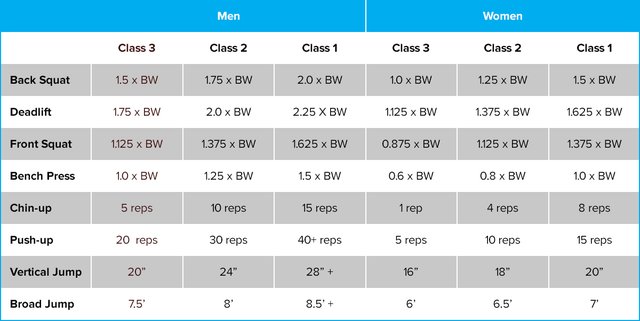
My standards are based on a class system, with Class 1 lifters being the most elite of the bunch. But of course, this brings problems, because there are bound to be plenty of people who meet the top standard on one movement, but are barely in Class 3 on the others. So, before explaining anything else, let me say this: Don't take the standards personally.
Regardless of where you fit on the scale above, it's not a statement on your worth as human being. I'm sure you're awesome, and this is just one man's opinion regarding strength and power development.
That said, the list is designed so that there's a checks-and-balances system. You might be great with some of the external loading exercises such as squats and deads, but struggle more with exercises that put a focus on body weight or explosive power. Or vice versa.
This is normal! But at the same time, it should make you wonder: "How much more impressive of an athlete would I be if all my weaknesses were in the same class as my strength?" Yes, it would be challenging to get there, but it might be just the challenge you need.
One other word about the external loading: It's perfectly OK to use a rep test instead of a one-rep max, or 1RM. You may not be comfortable doing 1RM testing on the big strength exercises, and that's totally fine. Rep-max calculators exist for just this reason! Just keep in mind that the more reps you perform, the less accurate rep-max calculations are.
Base your rep maxes on no more than 5 reps. So, if you weigh 180 pounds and want to test your deadlift, you don't need to grind through a single nose-bleeding rep at 360 to meet the standard in Class 2. Performing 4 reps at 340 or 5 reps at 330 will do the job.
Now, without any further ado, let's look at why I chose these moves, and how you'll test yourself on them.
Back Squat
I love front squats, but the back squat is the ultimate demonstration of hip and leg strength. Plus, throwing a bar on your back will help you throw a bit more weight on the bar, so it's great for setting standards when it comes to performance goals.
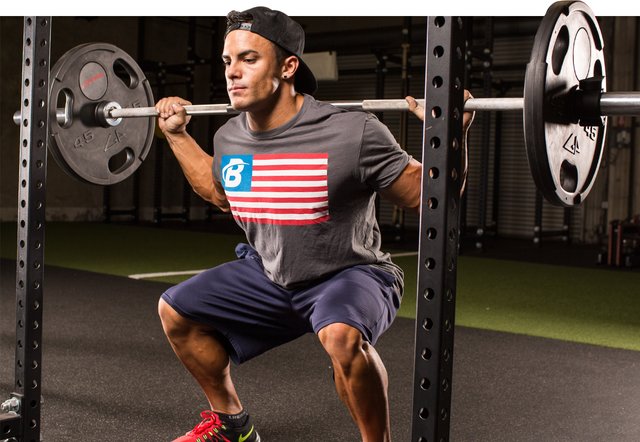
Back squat
Back-squat test: To test your back squat, place the bar on your back, and walk it out. Squat down until the tops of your thighs are at or below your knees, then return to the starting position. A weight that you can squat with perfect technique for 3-5 reps is sufficient.
Deadlift
There's a good reason why squats and deads are in the powerlifting trinity! The back and hip strength a conventional deadlift or sumo deadlift demands complements the leg strength of your back squat perfectly. And while the squat can be a bit more technical, the deadlift is easier to test—when done correctly. Simply load up the bar, grip, and rip!
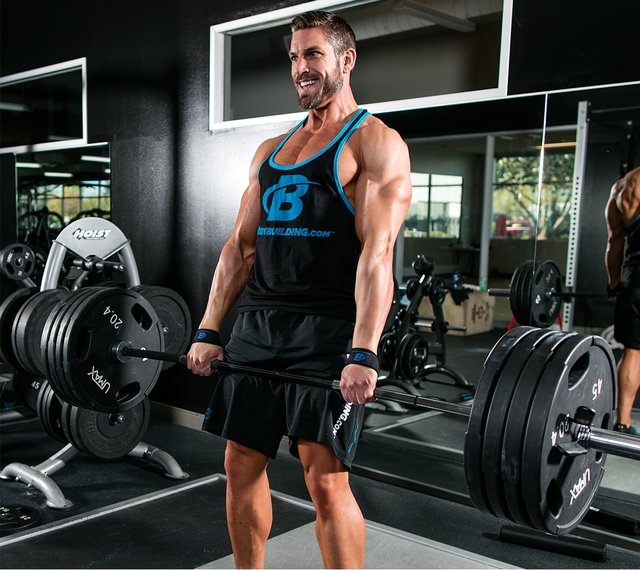
Deadlift
Deadlift test: Like I said, just load it and go! The only rule I have here is that you can't "hitch" or "ramp" the bar up your body. In other words, no resting the bar on your thighs. It has to come up in one smooth motion, even if it slows down. If you're testing for reps rather than a 1RM, your form should be as solid on the final rep as the first one.
Front Squat
Your front squat is worth testing separately from your back squat, since the moves are considerably different. For one, the front squat puts you in a very upright position, which is a bit safer for the spine. The front squat also puts a premium on quadriceps strength, which every weekend warrior needs for a bigger vertical jump or faster acceleration. Last but not least, if you ever miss this lift, you can simply dump the bar forward, making it safe to test.
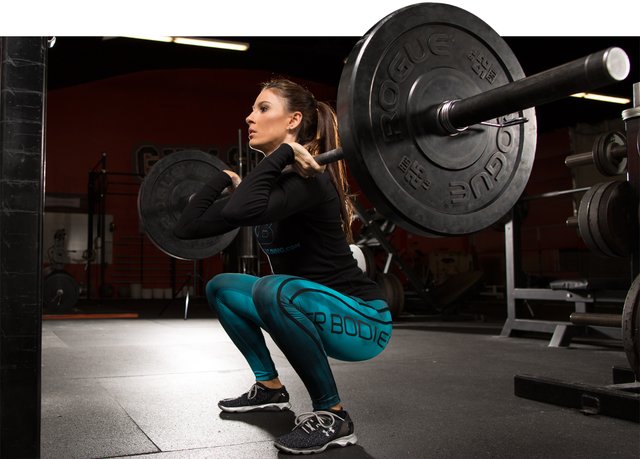
Front squat
Front-squat test: Rack the bar across the front of your shoulders using either a bodybuilder or Olympic-style grip—your choice. Walk it out, and set your feet approximately hip- to shoulder-width apart. Squat down until the tops of your thighs are at or below parallel to the knees, then return to the starting position.
Bench Press
This wouldn't be a true "strength standards" article without the bench press. And for good reason! The bench press is the gold standard when it comes to pure upper-body strength.
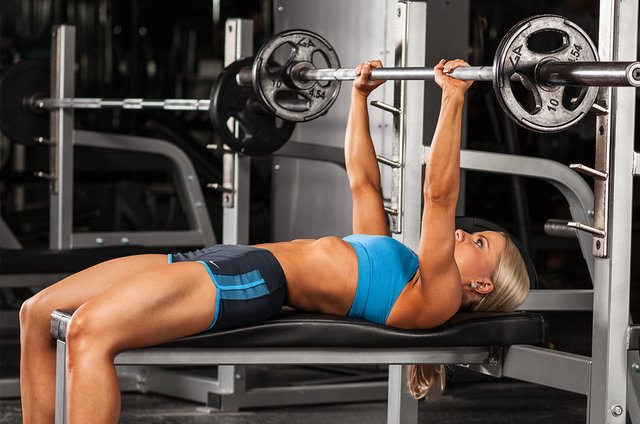
Bench press
Bench-press test: Lie on your back, and unrack the barbell. Lower it in a controlled fashion to the middle of your chest, then press back up to the starting position. Powerlifters are meticulous with their technique, but I don't necessarily expect that level of precision. My only demands: Don't bounce or heave the bar off your chest, and keep your butt down on the bench throughout each rep.
Chin-Up
The first few exercises here look a lot like a powerlifting meet, with a premium placed on using an external load. Great athletes are not only good at moving external loads, but they also own their own body weight as well.
Enter the chin-up. The chin-up is a great gauge of strength, because it taxes the muscles of the upper back. Furthermore, it's difficult to perform a ton of chin-ups if you carry too much extra body weight, so there's a premium here on relative strength.
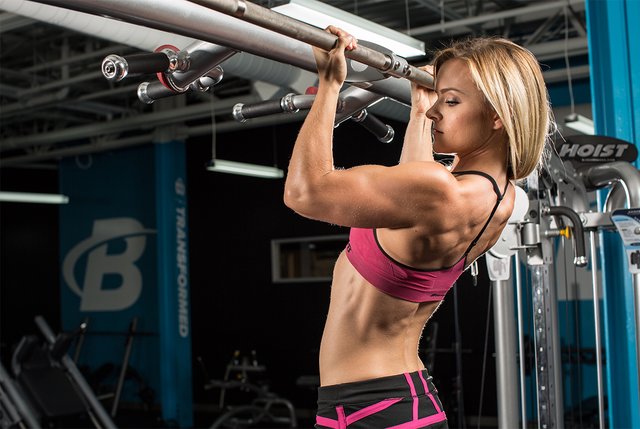
Chin-up
Chin-up test: Grab a chin-up bar with a supinated (palms facing you) grip. Allow the elbows to go straight in the bottom, and pull yourself in one smooth motion to a point where your upper chest is touching the bar. Return to the starting position, stop your momentum, and repeat for maximal reps.
Push-Up
Much like the chin-up, the push-up is a great demonstration of your ability to own your body weight. And unlike the bench press, which is almost solely upper-body focused, the push-up forces you to tie together the upper body, core, and lower body for maximum performance.
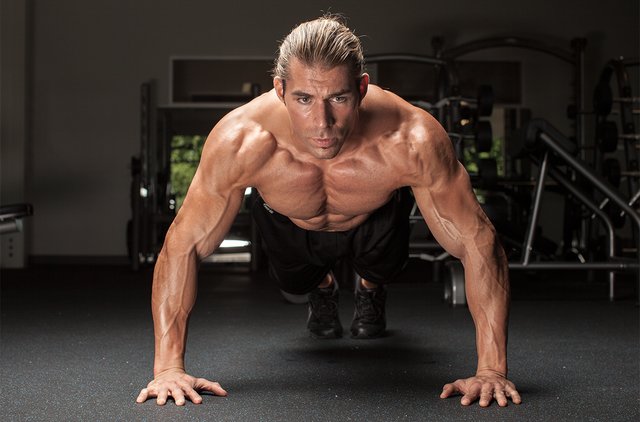
Push-up
Push-up test: Set up in a push-up position with your hands just outside of shoulder width, your spine in a neutral position, and the core engaged. Lower down to a lacrosse ball or similar-sized object to make sure you're using a full range of motion. Last but not least, focus on getting a full reach at the top, spreading your shoulder blades and pushing your torso as far away from the floor as possible.
Vertical Jump
The final two tests will put a premium on explosive strength and power. Much like the bodyweight tests, you might be awesome at moving external loads, or even performing movements where strength endurance is the primary focus, and find yourself deficient here. However, the ability to be fast and explosive is a critical element for any athlete, and the vertical jump is, and has always been, a premiere way of measuring these attributes.
Vertical-jump test: The easiest way to test your vertical jump is to use a Just Jump mat or Vertec device, as they can give you your numbers immediately. However, if you don't have access to one of these tools, try this old-school workaround:
- Stand next to a wall, and put chalk on your hands. Reach as high as you can, and place a fingertip at the point of your highest reach.
- Once completed, stand up tall with your arms outstretched overhead. Quickly rip your arms down and then back up while simultaneously bending and then extending your hips and knees to jump straight up. Touch as high as possible, using the chalk to make another mark.
- Take 3-5 attempts, then measure the difference between your standing reach and your maximum vertical jump.
Broad Jump
While many coaches fall in love with the vertical jump, the broad jump may be an equally powerful assessment tool.
The broad jump is fantastic, because it accurately assesses the explosive power of the posterior chain, particularly the glutes and hamstrings. Along those same lines, many sports have a high demand for horizontal power, which makes the broad jump a great indicator of potential performance.
Broad-jump test: Take a tape measure and stretch it out, placing a plate on both ends to keep it taut. Start with your toes at the 0 mark.
Stand up tall with your arms outstretched overhead, and quickly rip your arms down and then back while simultaneously bending and then extending your hips and knees to propel yourself forward. Stick the landing, and mark where your heel lands to determine your broad jump.
How Did You Do?
Like any test, you probably won't ace things right away—especially if you haven't studied for the exam! However, with some dedicated work, I guarantee you can make some significant improvements in all areas of your strength and power development.
If you're looking for a program to help you maximize some or all of these skills, I've got that, too. Just take a four- or eight-week ride on "The Program that Will Make You Better At Any Sport" and get back to me in the comments.
Make it a goal to improve on one, two, or even more of these tests in the coming months. I guarantee if you do this, you'll love the performance and physique changes that result!







0 comments:
Post a Comment